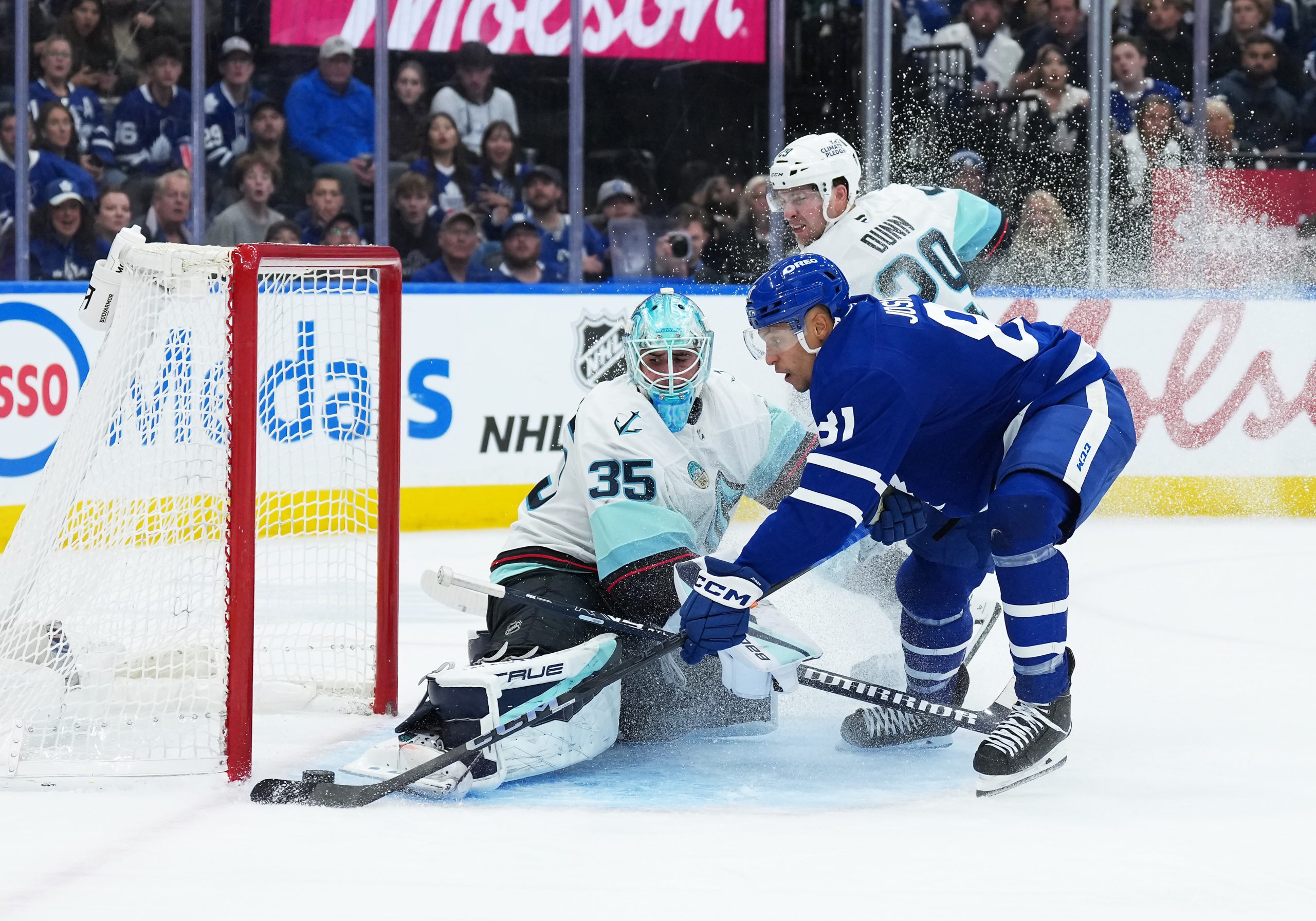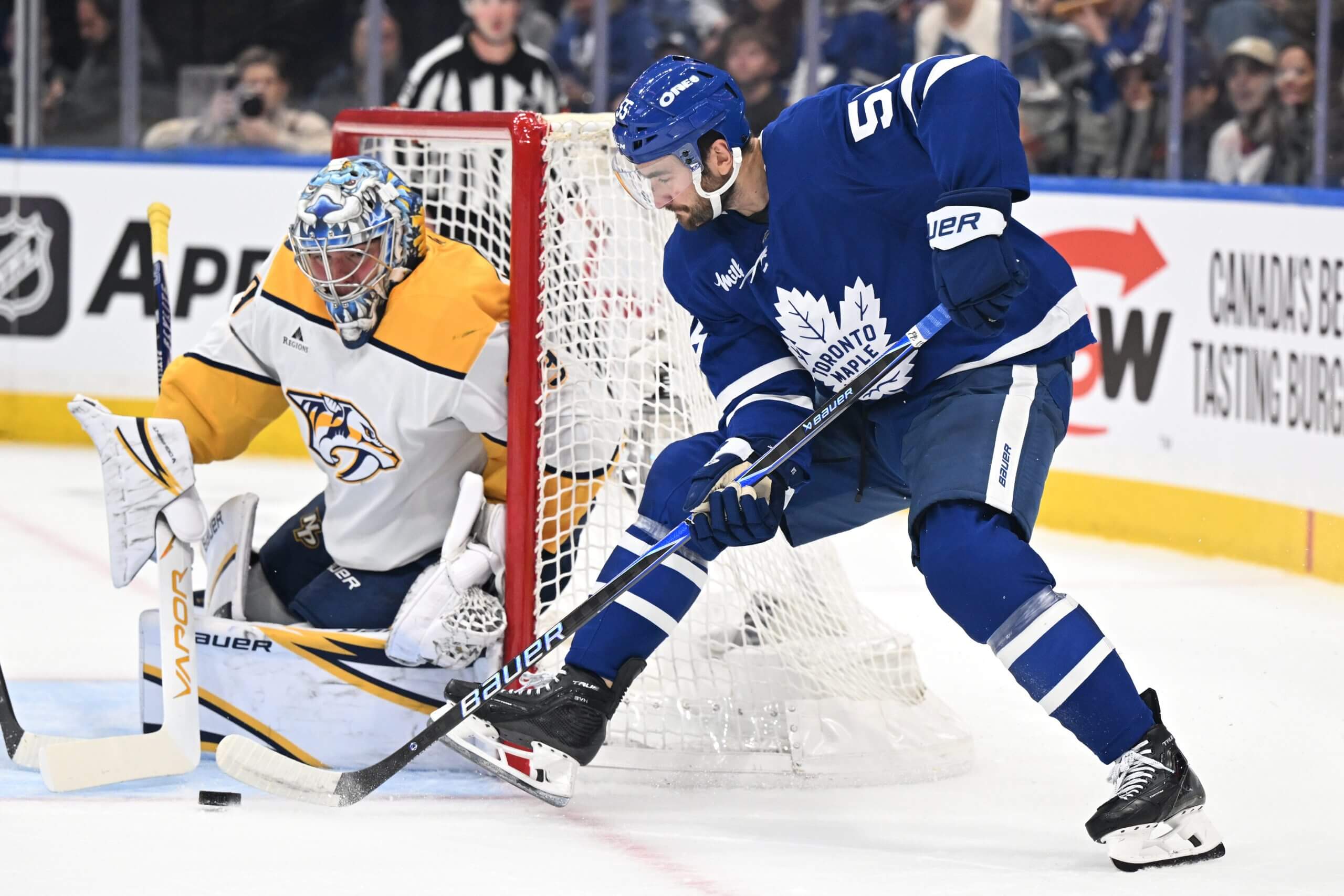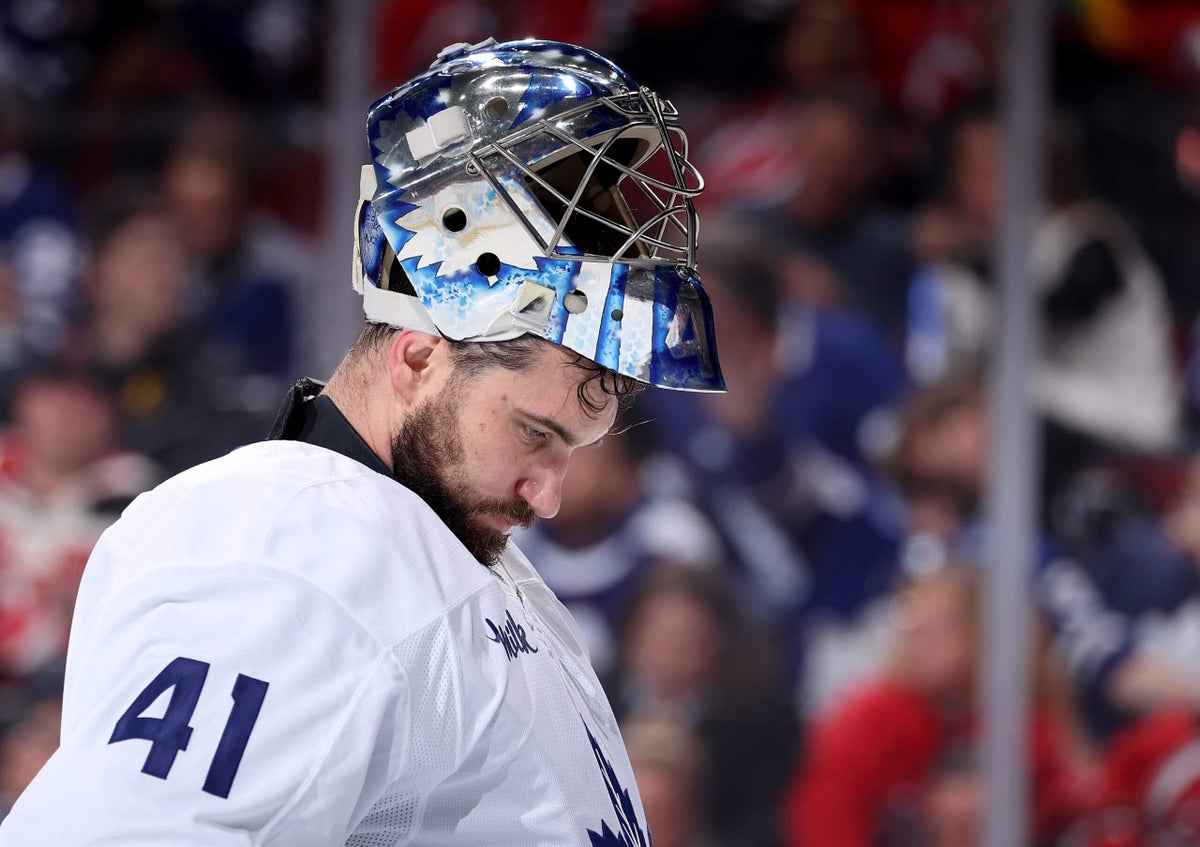What made Anthony Stolarz’s stinging criticism over the weekend so remarkable? The rarity of it.
Stolarz was unsparing in his critique of the team’s play, going further than just about anyone from the Toronto Maple Leafs — players, coaches, management — in recent memory in shredding the team’s performance against the Seattle Kraken on Saturday.
“How many points are we gonna leave out there?” Stolarz said after the 4-3 overtime loss, still pissed by the way it all went down. “We have the skill, we have the grit, we have the grind. It’s just frustrating that we just can’t put it together right now.”
It didn’t matter to him that it’s October, that the Leafs are only six games into the season, that new players were still getting acclimated. The Leafs’ No. 1 goaltender thought a standard wasn’t being met and said so.
“A lot of guys have been here for a while,” Stolarz said. “We do have some time to gel. But at the end of the day, too, it’s more or less just about working hard.”
There simply hasn’t been enough of that kind of blunt, unfiltered talk over the years from this team, at least publicly. Nobody spoke like Stolarz did after any one of the crushing postseason defeats over the years, including in the aftermath of a Game 7 drubbing by the Florida Panthers last spring.
That’s not totally fair, of course, because what players, coaches and members of management say in a press conference isn’t fully representative of what goes on behind closed doors or how those same people actually feel.
But actions matter.
And whether it’s the way the team has performed in the biggest games when it lacked a burning, bubbling, will-not-be-denied desire to win, or the way the organization has demonstrated that failing to advance deep in the postseason was acceptable by repeatedly bringing back the core of the same team (even attempting to do so last summer), true accountability has often been missing.

Anthony Stolarz wants more passion from his team. (Rick Osentoski / Imagn Images)
Stolarz said, bluntly, that this kind of performance wasn’t good enough and shouldn’t be accepted. That the team needed to play with more passion, both in defending the net and attacking it at the other end.
Jake Muzzin occasionally served as the public conscience of the team in that same way. So did Jason Spezza. Frederik Andersen once torched the team’s play after a game in Philadelphia. But no player (the leadership of the team, especially) went quite so far as Stolarz, who demonstrated, not just in his comments but in his actions on the ice (tossing the net away in frustration to chase down Mason Marchment), rage from a losing effort.
The Leafs have needed more of that on the ice — more fire, more passion, more internal accountability.
Stolarz has done this twice already this fall. He can’t keep doing it every night. He’ll have to pick and choose the times when this kind of lambasting is warranted or risk losing the support of his teammates and/or dividing the room.
Singling out teammates, like he did with William Nylander’s effort on Josh Mahura’s OT winner, probably wasn’t a good idea either. Stolarz likely wouldn’t want Nylander, who ranks among the league leaders in scoring, blasting his performance in goal in a postgame scrum following a rough night.
And Stolarz can only get away with this kind of critique if he maintains the standard of play he set last season. He’s undoubtedly played well at times in the early going this fall, especially considering some porous defensive play. However, his save percentage stands at .897 through five starts.
This kind of accountability, from the people that matter most, can be a good thing. It may spark something new from this team.
Lineup issues
One thing is very clear: Craig Berube is still struggling to figure out how best to piece together this group of forwards, particularly the top two lines.
“It’s not good enough, not consistent enough — I’m not seeing enough,” Berube said of the top six after the loss Saturday.
Not one combination, top-six or bottom-six, has worked with any lasting success.
Who should play with Auston Matthews and Matthew Knies?
After a very promising start, Easton Cowan has looked more and more like a 20-year-old leaping straight from junior into the NHL — and onto a top line in the NHL, for that matter. Though Cowan drew two penalties Saturday and continues to do a few intriguing things every night, he also struggled to make positive plays with the puck against the Kraken and was dropped from the top line after two periods and replaced by Nylander.
That threesome produced the Leafs’ first goal against the Kraken, when Nylander joined Matthews and Knies for an offensive zone faceoff, but they haven’t exactly sizzled in their limited minutes together this fall.
Nylander is the third right winger — after Cowan and Matias Maccelli — that Berube has tried on the top line, and fourth if you include Max Domi’s oh-so-brief spin there in training camp.
This was the look that Berube deployed for most of the third period over the weekend:
Matthew Knies – Auston Matthews – William Nylander
Nick Robertson – John Tavares – Bobby McMann
Dakota Joshua – Max Domi – Matias Maccelli
Steven Lorentz – Nicolas Roy – Easton Cowan
Who should play with Nylander and John Tavares?
Maccelli played less than 12 minutes against the Kraken, a season low, and drew only four shifts in the third period after a demotion from the top six.
The vision and the playmaking have been evident in pockets but haven’t translated to anything tangible: Maccelli has collected one point so far, an assist in the season opener against the Montreal Canadiens.
Already, Berube has tried Maccelli and Bobby McMann with Nylander and Tavares, continuing a trend that’s been ongoing for years.
Now what?
The Leafs need at least one of their offseason bets on Maccelli and Dakota Joshua to pay off.
Joshua had a strong drive to the net Saturday, but couldn’t stuff the puck past Joey Daccord. He, too, has only one point (an assist) so far and hasn’t made much of an impact physically.

Dakota Joshua is still looking for his first goal as a Leaf. (Nick Turchiaro / Imagn Images)
Berube quickly went back to the third line of Domi with McMann and Nick Robertson this fall. That group was burned for two goals against Seattle and has produced only one goal all season.
The real problem, and one Berube has presumably addressed with GM Brad Treliving, is a lack of true top-six talent beyond Matthews, Nylander, Knies and Tavares.
10 things I like, don’t like, or find interesting
1. Did Stolarz have a point about the Leafs lacking enough net-front disturbance on offence?
Last season, the Leafs mustered 11.4 high-danger attempts on goal per 60 minutes. This season, they’re closer to 11. Still around middle of the pack league-wide.
Berube and Stolarz were both irked by the team’s play around their own net, too. Berube saw a decline in clearing out bodies from the blue paint from last season. And indeed, the Leafs are yielding around 12 high-danger attempts per 60, up from closer to 11 last season.
2. The worst offenders on the back end in that area, at least in terms of the number of high-danger attempts allowed by the team in their minutes: Oliver Ekman-Larsson and Brandon Carlo.
3. The Leafs wanted a more involved and aggressive Morgan Rielly this season, and they’re getting it.
Rielly’s shot and attempt rate through six games would be the highest of his NHL career. So would his rate of production— 2.8 points per 60 minutes.
4. Matthews is playing huge minutes. He logged over 23 minutes Saturday and sits fifth in the league at about 22 per game.
That would be a career high for Matthews. It’s about a minute and a half more than he logged on average last season (20:28), and the increase has come at five-on-five.
The Leafs needed someone(s) to play more in Mitch Marner’s absence. One has been Matthews. The other is Knies, drawing almost 21 minutes per game, a top-20 mark in the league. The increased usage explains why the Leafs plan to limit Matthews’ practice participation at times during the season.
5. The Leafs lost their best playmaker in the offseason. Enter Nylander.
A 40-goal scorer in each of the previous three seasons, Nylander seems to have entered this season intent on creating scoring opportunities for others. He already has nine assists this season and no cheapies either, with eight primary helpers.
Nylander assisted on two of three goals Saturday and has had a hand in exactly half of the Leafs’ 22 goals this season.

William Nylander has played the role of playmaker early this season. (Dan Hamilton / Imagn Images)
Minus Marner, the Leafs needed someone(s) to pick up the playmaking load. The current forward group only has a couple of pass-first types in Maccelli and Domi, and they’ve combined for just one assist so far.
In other words, Nylander’s desire to create for others has been mighty helpful. And yet …
6. The Leafs also need Nylander to score. And they need him shooting more to do it. A lot more.
Nylander has only 11 shots. His current shot rate (5.5 shots per 60 minutes) would be the lowest of his NHL career by far. He is especially lacking in attempts around the net. He has just two shots from high-danger zones. Last season, Nylander ranked in the NHL’s 92nd percentile in high-danger shots, with 68. Nineteen of those shots went in for goals.
Nylander’s playmaking instincts are a good thing. The Leafs need a little more balance from him, though. His shot is too valuable to waste.
7. It’s early, but Nicolas Roy should be playing more.
Roy is averaging just 12 minutes per game, more than three minutes less than he averaged with Vegas last season and a bit less than current Toronto Marlie (and last year’s fourth-line centre) David Kämpf drew on average last season (12:24).
Roy was supposed to be the Leafs’ 3C this season. Then 4C Scott Laughton got hurt, and Berube scrambled his lineup by reinstalling Domi into the third line. That’s led to fewer opportunities for Roy, who averaged about 15 minutes for Vegas.

Nicolas Roy isn’t playing a lot in his early days as a Leaf. (Dan Hamilton / Imagn Images)
Roy’s underlying numbers don’t sparkle at the moment (43 percent expected goals rate). However, he’s scored a goal, set up another with limited opportunity and brought some heaviness to the Leafs’ attack. Unlike Kämpf, Roy can bring a little offence to the party on top of defensive stability.
8. What might help Roy? More faceoff wins.
Part of what made the 28-year-old appealing to the Leafs was the promise he brought as a legitimate right-handed faceoff man. The Leafs haven’t had one of those since Spezza retired.
The problem: Roy isn’t winning enough draws just yet. His success rate: 44.6 percent.
9. Berube is getting a shoot-first version of Domi, who ranks fourth on the team with 12 shots.
I’m not sure that’s a good thing, though. Domi’s best skill is his ability to pass the puck. Through six games, he has zero assists. Every other forward, save for Calle Järnkrok, has collected at least one.
10. Matthews has already blocked 16 shots. That’s tops among NHL forwards.

